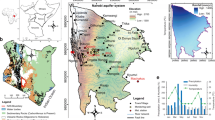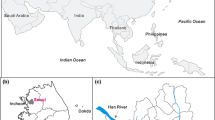Abstract
Urbanization, in particular, the culverting and burying of streams in sewer infrastructure, has affected both surface and subsurface flow regimes. While researchers have examined the impact of stream burial on groundwater budgets, field studies examining the influence of urbanization on groundwater dynamics are relatively scarce. This study analyzes tidal patterns in water-level data from shallow groundwater monitoring wells located next to a legacy sewer line within the city of Philadelphia, Pennsylvania, USA. The coupling of historic records, sewer network maps, and well bore hydrogeology explains spatial patterns in groundwater elevations. Furthermore, a synthesis of early twentieth century United States census data, and continental scale GIS data demonstrates the potential for groundwater inundation in coastal United States cities that are served by aging sewer infrastructure. Altered groundwater flow dynamics caused by sea level rise, coupled with climatic shifts will likely stress aging sewer infrastructure, and can lead to increased discharge of combined sewer overflow systems and flooding.





Similar content being viewed by others

References
Ana E, Bauwens W, Pessemier M, et al (2008) Investigating the effects of specific sewer attributes on sewer ageing a Belgian case study. In: 11th International Conference on Urban Drainage. Edinburgh, Scotland, UK, pp 1–10
Berg TM, Edmunds WE, Geyer AR, Glover AD, Hoskins DM, MacLachlan DB, Root SI, Sevon WD, Socolow AA (1980) Geologic map of Pennsylvania (2nd edition): Pennsylvania Geological Survey, 4th series, Map 1, 3 sheets, scale 1:250,000
Bhaskar AS, Welty C (2012) Water balances along an urban-to-rural gradient of metropolitan baltimore, 2001–2009. Environ Eng Geosci 18:37–50. https://doi.org/10.2113/gseegeosci.18.1.37
Bjerklie DM, Mullaney JR, Stone JR et al (2012) Preliminary Investigation of the effects of sea-level rise on groundwater levels in New Haven, Connecticut. US Geol Surv Open File Rep 2012:1–46
Broadhead AT, Horn R, Lerner DN (2013) Captured streams and springs in combined sewers: a review of the evidence, consequences and opportunities. Water Res 47:4752–4766. https://doi.org/10.1016/j.watres.2013.05.020
Broadhead AT, Horn R, Lerner DN (2015) Finding lost streams and springs captured in combined sewers: a multiple lines of evidence approach. Water Environ J 29:288–297. https://doi.org/10.1111/wej.12104
Bromley GW, Bromley WS (1895) Atlas of the city of Philadelphia, 1895. G.W. Bromley and Co., Philadelphia
Bromley GW, Bromley WS (1910) Atlas of the city of Philadelphia, 1910. G.W. Bromley and Co., Philadelphia
Chirico PG, Epstein JB (2000) Geographic information system analysis of topographic change in Philadelphia, Pennsylvania, during the last century. US Geol Surv Open-File Rep 2000:1–13
Delaware River Basin Commission (2019) Salt line location. https://www.state.nj.us/drbc/hydrological/river/salt-line.html. Accessed 18 March 2019
Divers MT, Elliott EM, Bain DJ (2013) Constraining nitrogen inputs to urban streams from leaking sewers using inverse modeling: implications for dissolved inorganic nitrogen (DIN) retention in urban environments. Environ Sci Technol 47:1816–1823. https://doi.org/10.1021/es304331m
Ellis JB, Revitt DM, Blackwood DJ, Gilmour DJ (2004) Leaky sewers: assessing the hydrology and impact of exfiltration in urban sewers. In: Webb B, Acreman M, Maksimovic C et al (eds) hydrology: science and practices for the 21st century. British Hydrological Society, Imperial College, London, pp 266–271
Ferris JG (1951) Cyclic fluctuations of water level as a basis for determining aquifer transmissibility. In: International Union of Geodesy and Geophysiscs, Association of Scientific Hydrology Assembly, pp 148–155
Fetter CW (2001) Applied hydrogeology, 4th edn. Prentice Hall, Upper Saddle River
Goebel M, Pidlisecky A, Knight R (2017) Resistivity imaging reveals complex pattern of saltwater intrusion along Monterey coast. J Hydrol 551:746–755. https://doi.org/10.1016/j.jhydrol.2017.02.037
Hibbs BJ, Sharp JM (2012) Hydrogeological impacts of urbanization. Environ Eng Geosci 18:3–24
Hopkins KG, Bain DJ, Copeland EM (2013) Reconstruction of a century of landscape modification and hydrologic change in a small urban watershed in Pittsburgh, PA. Landsc Ecol 29:413–424. https://doi.org/10.1007/s10980-013-9972-z
Jacob CE (1950) Flow of groundwater. In: Rouse H (ed) Engineering hydraulics. Wiley, New York, pp 321–386
Kim Y-Y, Lee K-K, Sung IH (2001) Urbanization and the groundwater budget, metropolitan Seoul area, Korea. Hydrogeol J 9:401–412. https://doi.org/10.1007/s100400100139
Lerner DN (1986) Leaking pipes recharge ground water. Groundwater 24:654–662. https://doi.org/10.1111/j.1745-6584.1986.tb03714.x
Machusick M, Welker A, Traver R (2011) Groundwater mounding at a storm-water infiltration BMP. J Irrig Drain Eng 137:154–160. https://doi.org/10.1061/(ASCE)IR.1943-4774.0000184
Mao X, Enot P, Barry DA et al (2006) Tidal influence on behaviour of a coastal aquifer adjacent to a low-relief estuary. J Hydrol 327:110–127. https://doi.org/10.1016/j.jhydrol.2005.11.030
Miles CE, Whitfield TG et al (2001) Bedrock geology of Pennsylvania: Pennsylvania Geological Survey, 4th series, dataset, scale 1:250,000. http://www.dcnr.state.pa.us/topogeo/publications/pgspub/map/map1/index.htm. Accessed 17 May 2017
NOAA Center for Operational Oceanographic Products and Services (2017) Observed Water Levels. https://tidesandcurrents.noaa.gov/waterlevels.html?id=8545240. Accessed 13 Mar 2017
Parliamentary Office of Science and Technology (2007) Urban flooding. POST Note 289:1–4
Paulachok GN (1991) Geohydrology and ground-water resources of Philadelphia. U.S. Geological Survey Water Supply Paper 2346
Pennsylvania Bureau of Topographic and Geologic Survey Deparment of Conservation and Natural Resources (1995) Physiographic Provinces 1:100,000. http://www.pasda.psu.edu. Accessed 17 May 2017
Pennsylvania Department of Transportation Bureau of Planning and Research Geographic Information Division (2017) PennDOT—pennsylvania stateroads. http://www.pasda.psu.edu. Accessed 17 May 2017
Philadelphia Department of Public Works Bureau of Surveys (1902) Main sewerage systems of the city of Philadelphia 1902. Dunlap Printing Co., Philadelphia
Philadelphia Water Department (2014) 2014 drinking water quality report. Philadelphia Water Department, Philadelphia, pp 1–25
Philadelphia Water Department (2017) Combined sewer area. http://www.phillywatersheds.org/what_were_doing/maps/kml. Accessed 15 May 2017
R Core Team (2016) R: A language and environment for statistical computing. R Foundation for Statistical Computing. Vienna, Austria. https://www.Rproject.org/
Rotzoll K, Fletcher CH (2012) Assessment of groundwater inundation as a consequence of sea-level rise. Nat Clim Chang 3:477–481. https://doi.org/10.1038/nclimate1725
Semadeni-Davies A, Hernebring C, Svensson G, Gustafsson L-G (2007) The impacts of climate change and urbanisation on drainage in Helsingborg, Sweden: combined sewer system. J Hydrol 350:100–113. https://doi.org/10.1016/j.jhydrol.2007.05.028
Seto KC, Fragkias M, Güneralp B, Reilly MK (2011) A meta-analysis of global urban land expansion. PLoS One 6:e23777. https://doi.org/10.1371/journal.pone.0023777
Sharp JM (2010) The impacts of urbanization on groundwater systems and recharge. Aqua Mundi 1:51–56. https://doi.org/10.4409/Am-004-10-0008
Shuster WD, Dadio S, Drohan P et al (2014) Residential demolition and its impact on vacant lot hydrology: implications for the management of stormwater and sewer system overflows. Landsc Urban Plan 125:48–56. https://doi.org/10.1016/j.landurbplan.2014.02.003
United Nations (2014) World Urbanization Prospects: The 2014 Revision, Highlights. Department of Economic and Social Affairs. Population Division, United Nations
United States Bureau of the Census (1907) Special Reports: statistics of cities having a population of over 30,000: 1905. Government Printing Office, Washington, DC
United States Bureau of the Census (2010) Census of the United States. Government Printing Office, Washington, DC
United States Census Bureau (2016) Cartographic boundary shapefiles—urban areas. https://www.census.gov/geo/maps-data/data/cbf/cbf_ua.html. Accessed 1 Jun 2017
United States Census Bureau Population Division (2017) Annual estimates of the resident population: April 1, 2010 to July 1, 2016. https://factfinder.census.gov/faces/nav/jsf/pages/index.xhtml. Accessed 16 Jun 2017
United States Environmental Protection Agency (2016) Report to Congress: Clean Watersheds Needs Survey 2012. Report EPA-830-R-15005
United States Geological Survey (2017) USGS water data for USA. In: Natl. Water Inf. Syst. https://waterdata.usgs.gov/nwis. Accessed 16 Jun 2017
Acknowledgements
The authors wish to thank Tyler Wong with assistance during well tests, and Juan Lezama with assistance during the spectral analysis. This work was funded by the Pennsylvania Department of Transportation under TEM WO 006 and a subcontract through AECOM.
Author information
Authors and Affiliations
Corresponding author
Additional information
Publisher's Note
Springer Nature remains neutral with regard to jurisdictional claims in published maps and institutional affiliations.
Electronic supplementary material
Below is the link to the electronic supplementary material.
Rights and permissions
About this article
Cite this article
Rossi, R.J., Toran, L. Exploring the potential for groundwater inundation in coastal US cities due to interactions between sewer infrastructure and global change. Environ Earth Sci 78, 258 (2019). https://doi.org/10.1007/s12665-019-8261-9
Received:
Accepted:
Published:
DOI: https://doi.org/10.1007/s12665-019-8261-9



